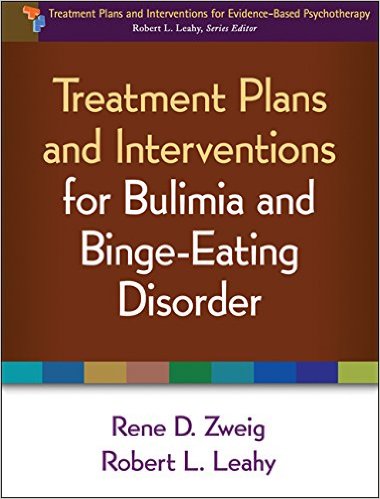
Reprinted from Eating Disorders Review
May/June 2012 Volume 23, Number 3
©2012 Gürze Books
Treatment Plans and Interventions for Bulimia and Binge-Eating Disorder |
Sooner rather than later, clinicians working with eating disorders patients find themselves wanting to or, thanks to insurance companies, managed care companies, and/or other regulatory bodies having to develop formal treatment plans for their patients. Formal treatment planning offers many clear benefits: The process requires the clinician (hopefully in collaboration with the patient) to think through and explicate the long-term goals and shorter- term objectives to be accomplished through treatment, and thereby make certain that they have a shared understanding and explanation of the issues to be addressed and how they will be addressed. When more than one clinician is involved, treatment plans can also help assure that all players are on the same page. They can also be used to communicate with families about intentions and expectations about treatment. Comprehensive treatment plans may be formulated around broad-based models that consider problems described along bio-psycho-social-cultural-spiritual dimensions or other conceptual outlines, and ultimately align overall strategies and specific interventions with defined problems to be resolved.
To help clinicians think through these issues, and to provide clear step-by-step direction for clinicians using primarily a cognitive behavioral therapy approach to treat bulimia nervosa and binge-eating disorder, Drs. Zweig and Leahy, psychologists practicing in New York City (Dr. Leahy is also affiliated with Cornell Medical School) have written a detailed and highly instructive guide. As the second volume in a new series on “Treatment Plans and Interventions for Evidence Based Psychotherapies” edited by Dr. Leahy, the book offers a session-by-session map of how common problems might be addressed, from initial assessment including motivational assessment and psycho-education through behavioral methods, cognitive methods, and development of alternative coping strategies, constituting a typical 20-session treatment plan for adolescent and adult patients. The book is filled with useful worksheets, plus appendices with assessment instruments.
New practitioners and even veterans will find useful guidance for the basic CBT approach here. A chapter on “Treatment within a Managed Care Context” is particularly welcome, and covers issues of getting approval, medical necessity, writing initial treatment reports, and requesting additional sessions. However, the manual does not adequately address the assessment and management of those frequently encountered patients who in addition to straightforward bulimia nervosa or binge-eating disorder have psychiatric, substance-related, personality disordered and interpersonal comorbidities, requiring more enhanced treatment strategies.
Finally, the authors of this volume (and those of future volumes in this series) would serve their audiences well by also making the educational materials, worksheets, and assessment forms included in this volume available to readers electronically, by including a CD or providing a web site from which readers might print these materials for use with their patients during the course of routine practice.
— JY
